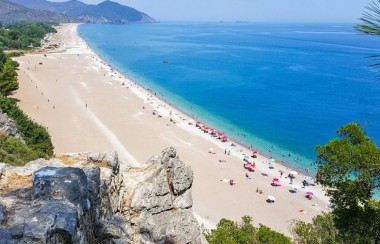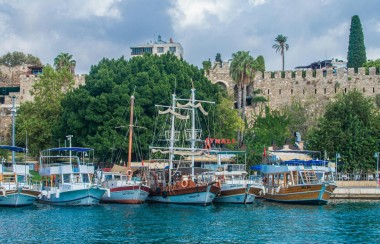Antalya Region
Antalya, Ancient Greek: Ἀττάλεια) is the eighth-most populous city in Turkey as well as the capital of Antalya Province.
King Attalus II of Pergamon is looked on as founder of the city in about 150 BC, during the Hellenistic period. It was named Attaleia or Attalia in his honour. The city served as a naval base for Attalus's powerful fleet. Excavations in 2008, in the Doğu Garajı plot, uncovered remains dating to the 3rd century BC, suggesting that Attalea was a rebuilding and expansion of an earlier town.
Statue of Attalus II in the city
Attalea became part of the Roman Republic in 133 BC when Attalus III, a nephew of Attalus II, bequeathed his kingdom to Rome at his death in 133 BC. The city grew and prospered during the Ancient Roman period and was part of the Roman province of Pamphylia Secunda, whose capital was Perga.
Christianity started to spread to the region even in the 1st century: Attalea was visited by Paul of Tarsus and Barnabas, as recorded in the Acts of the Apostles: "Then they passed through Pisidia and came to Pamphylia. And when they had spoken the word in Perga, they went down to Attalea, and from there they sailed to Antioch". Some of the bishops attributed to the episcopal see of Attalea in Pamphylia may instead have been bishops of Attalea in Lydia (Yanantepe), since Le Quien lists them under both sees. No longer a residential bishopric, Attalea in Pamphylia is today listed by the Catholic Church as a titular see.
The 13th-century Seljuk mosque at Attalea, now in ruins, had been a Christian Byzantine basilica from the 7th century. The Great Mosque had also been a Christian basilica and the Kesik Minare Mosque had been the 5th-century Christian Church of the Panaghia or Virgin and was decorated with finely carved marble. The archaeological museum at Attalea houses some sarcophagi and mosaics from nearby Perga and a casket of bones reputed to be those of St. Nicholas, the bishop of Myra, further down the Turquoise coast.
Attalea was a major city in the Byzantine Empire. It was the capital of the Byzantine Theme of the Cibyrrhaeots, which occupied the southern coasts of Anatolia. According to the research of Speros Vryonis, it was the major naval station on the southern Anatolian coast, a major commercial center, and the most convenient harbor between the Aegean Sea and Cyprus and points further east. Besides the local merchants, "one could expect to see Armenians, Saracens, Jews, and Italians."
At the time of the accession of John II Comnenus in 1118, Attalea was an isolated outpost surrounded by Turkish beyliks, accessible only by sea. Following the fall of Constantinople in 1204, Niketas Choniates records that one Aldebrandus, "an Italian by birth who was strictly raised according to Roman tradition" controlled Attalea as his own fief. When Kaykhusraw, sultan of the Seljuk Turks attempted to capture the city in 1206, Aldebrandus sent to Cyprus for help and received 200 Latin infantry who defeated the attackers after a siege of less than 16 days. Kaykhusraw would take Attalea the following year and build its first mosque. Christians rebelled and captured Attalea with aid of Walter of Montbéliard in 1212. Briefly restored Byzantine rule in Attalea was ended by Kaykaus I in 1216.
A panoramic view from Karaalioğlu Park with Historic Hıdırlık Tower.
The city and the surrounding region were conquered by the Seljuk Turks in the early 13th century. Attalea was the capital of the Turkish beylik of Teke (1321–1423) until its conquest by the Ottomans, except for a period of Cypriot rule between 1361 and 1373. The Arabic traveler Ibn Battuta, who visited the city in 1335–1340, noted:
From Alanya I went to Antaliya [Adalia], a most beautiful city. It covers an immense area, and though of vast bulk is one of the most attractive towns to be seen anywhere, besides being exceedingly populous and well laid out. Each section of the inhabitants lives in a separate quarter. The Christian merchants live in a quarter of the town known as the Mina [the Port], and are surrounded by a wall, the gates of which are shut upon them from without at night and during the Friday service. The Greeks, who were its former inhabitants, live by themselves in another quarter, the Jews in another, and the king and his court and Mamluks in another, each of these quarters being walled off likewise. The rest of the Muslims live in the main city. Round the whole town and all the quarters mentioned there is another great wall. The town contains orchards and produces fine fruits, including an admirable kind of apricot, called by them Qamar ad-Din, which has a sweet almond in its kernel. This fruit is dried and exported to Egypt, where it is regarded as a great luxury.
In the second half of the 17th century Evliya Çelebi wrote of a city of narrow streets containing 3,000 houses in 20 Turkish and four Greek neighborhoods. The town had grown beyond the city walls and the port was reported to hold up to 200 boats.
Vilayet of Adalia (Antalya) in 1890
In the 19th century, in common with most of Anatolia, its sovereign was a "dere bey" (landlord or landowner). The family of Tekke Oğlu, domiciled near Perge had been reduced to submission in 1812 by Mahmud II, but continued to be a rival power to the Ottoman governor until the early 20th century, surviving by many years the fall of the other great beys of Anatolia. The records of the Levant (Turkey) Company, which maintained an agency in Antalya until 1825, documented the local dere beys.
In the early 20th century, Antalya had two factories spinning and weaving cotton. As of 1920, the factories had 15,000 spindles and over 200 looms. A German-owned mill baled cotton. There were gin mills.
In the 20th century, the population of Antalya increased as Turks from the Caucasus and the Balkans moved into Anatolia. The economy was centered on its port that served the inland areas, particularly Konya. Antalya (then Adalia) was picturesque rather than modern. The chief attraction for visitors was the city wall, and outside a promenade, a portion of which survives. The government offices and the houses of the higher classes were outside the walls.
The Ottoman Houses in Kaleiçi.
As of 1920, Antalya was reported as having a population of approximately 30,000. The harbor was described as small, and unsafe for vessels to visit in the winter. Antalya was exporting wheat, flour, sesame seeds, livestock, timber and charcoal. The latter two were often exported to Egypt and other goods to Italy or other Greek islands, who received mainly flour. In 1920, the city had seven flour mills. Wheat was imported, and then processed in town before exportation. Antalya imported manufactured items, mainly from the United Kingdom. The city had a Greek minority that made up 1/3 of the population until the population exchange. Antalya also had a tiny Armenian population which had a church on the street of "Hamam çikmazi" named Hovhannes Surp Garabed, which was later on demolished. Antalya also had a Jewish community which had a tiny Synagogue in the neighborhood of Balbey and a Talmud Torah. The Synagogue was closed in 1948 and its exact location is not known and the Synagogue might not exist anymore. The Jewish community had 2 graveyards and one was located across "Donerciler carsisi"and was demolished when the area was opened to construction, but one marble tombstone belonging to a Jew named Raphael Moshe was transferred to the Antalya Museum where it can be seen in the museum garden.
The city was occupied by Italy for three years (1919-22) in the aftermath of World War I, but was recaptured by a newly independent Turkey in the War of Independence. Large-scale development beginning in the 1970s transformed Antalya from a pastoral town into one of Turkey's largest metropolitan areas. Much of this has been due to tourism, which expanded in the 21st century. In the 1985 singing diva Dalida held her last concert in Antalya.
Antalya was the host city for the 2015 G-20 summit and the EXPO 2016. Five countries have their consular missions in Antalya including Germany, Great Britain, Russia, Belgium and Serbia.
Antalya Tours
Related Tours
We Proudly Design Tailor Made Itineraries For Individuals And Groups.











